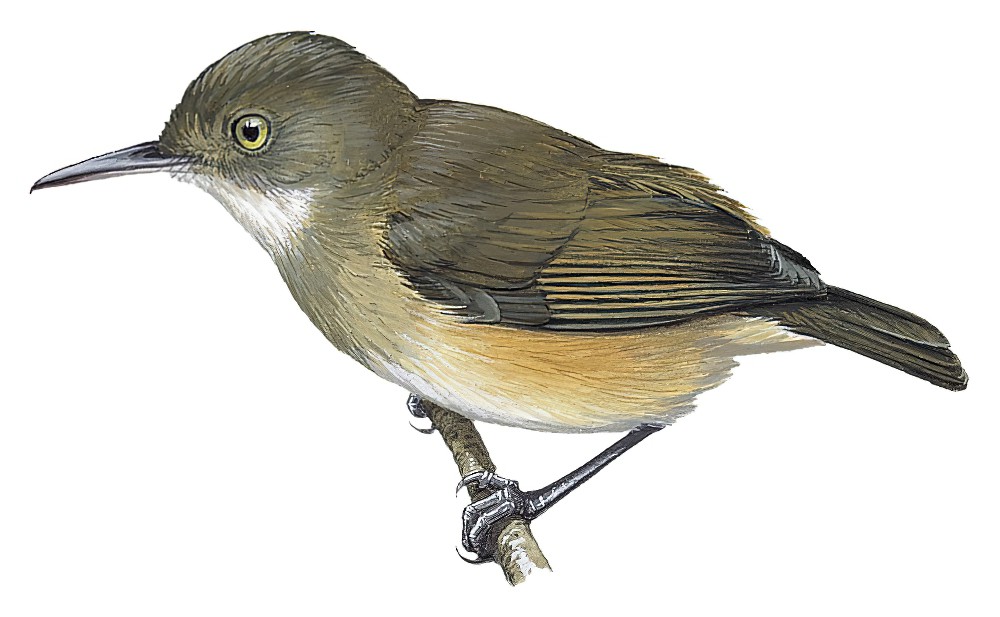Kemp’s Longbill / Macrosphenus kempi

Kemp's Longbill
SCI Name:
Protonym: Amaurocichla kempi Bull.Br.Orn.Club 15 p.38
Taxonomy: Passeriformes / Macrosphenidae / Macrosphenus
Taxonomy Code: kemlon1
Type Locality: Bo, Sierra Leone.
Author: Sharpe
Publish Year: 1905
IUCN Status: Least Concern
DEFINITIONS
MACROSPHENUS
(Macrosphenidae; Ϯ Yellow Longbill M. flavicans) Gr. μακρος makros long; σφην sphēn, σφηνος sphēnos wedge; "Genus MACROSPHENUS, nobis. General aspect of Orthotomus (O. sericeus, Temm.) and Ramphocænus (R. melanurus, Vieill.) but with the bill stronger, wider laterally and more compressed, and with the legs and feet stronger. Bill long, rather strong, straight, wide at base, compressed towards the end, upper mandible carinated, curved and distinctly notched at the tip, nostrils in a large membrane, under mandible rather thick, somewhat curved in its outline, ascending towards its tip. ... This genus, which I propose for the species immediately succeeding, is exactly that of a bird in the Rivoli collection now in the Museum of this Academy, labelled "Ramphocene vert, Ramphocenus viridis, Madagascar." ... This bird may be Ramphocænus viridis, Lesson, Traite d'Orn., p. 377, but which is stated by M. Lesson to be a species of Brazil. ... 70. MACROSPHENUS FLAVICANS, nobis. ... Hab. Camma River, Western Africa. Discovered by Mr. P. B. Duchaillu. The affinities of this bird, and that alluded to above, as probably from Madagascar, I have not satisfactorily determined. The general aspect is that of Orthotomus and Ramphocænus, as stated above, but they appear also to be related to Tatare, Lesson, and in fact have the bills very similar to that of Tatare luscinius or Thryothorus luscinius, Quoy et Gaim. Voy. Astrolabe, Ois. pl. 5. At present my opinion is that they belong to the group Troglodytinæ." (Cassin 1859).
Synon. Onychorhinus, Rectirostrum, Suaheliornis.
kempi
● Robert "Robin" Kemp (1871-1949) English accountant, naturalist, collector in Sierra Leone 1902-1904, New Zealand 1906-1907, East Africa 1908-1909, Australia 1912-1914, and Argentina 1916-1917 (syn. Chalcophaps longirostris rogersi, syn. Chloebia gouldiae, subsp. Cinnyris chloropygius, subsp. Cracticus mentalis, syn. Dacelo leachii, syn. Egretta garzetta immaculata, subsp. Estrilda astrild, syn. Falco berigora, subsp. Kempiella griseoceps, Macrosphenus, syn. Myiagra ruficollis mimikae, syn. Myzomela erythrocephala infuscata, subsp. Philemon argenticeps, syn. Polyboroides typus pectoralis, syn. Puffinus elegans, syn. Rhipidura fuliginosa placabilis, syn. Rhipidura rufifrons, syn. Sterna sumatrana, subsp. Tockus erythrorhynchus).
● Dr Stanley Wells Kemp (1882-1945) British marine biologist, explorer, Superintendent of the Zoological Survey of India 1910-1924, Director of Plymouth Marine Laboratory 1936-1945 (syn. Rhipidura albicollis stanleyi).
SUBSPECIES
Kemp's Longbill (kempi)
SCI Name: Macrosphenus kempi kempi
kempi
● Robert "Robin" Kemp (1871-1949) English accountant, naturalist, collector in Sierra Leone 1902-1904, New Zealand 1906-1907, East Africa 1908-1909, Australia 1912-1914, and Argentina 1916-1917 (syn. Chalcophaps longirostris rogersi, syn. Chloebia gouldiae, subsp. Cinnyris chloropygius, subsp. Cracticus mentalis, syn. Dacelo leachii, syn. Egretta garzetta immaculata, subsp. Estrilda astrild, syn. Falco berigora, subsp. Kempiella griseoceps, Macrosphenus, syn. Myiagra ruficollis mimikae, syn. Myzomela erythrocephala infuscata, subsp. Philemon argenticeps, syn. Polyboroides typus pectoralis, syn. Puffinus elegans, syn. Rhipidura fuliginosa placabilis, syn. Rhipidura rufifrons, syn. Sterna sumatrana, subsp. Tockus erythrorhynchus).
● Dr Stanley Wells Kemp (1882-1945) British marine biologist, explorer, Superintendent of the Zoological Survey of India 1910-1924, Director of Plymouth Marine Laboratory 1936-1945 (syn. Rhipidura albicollis stanleyi).
Kemp's Longbill (flammeus)
SCI Name: Macrosphenus kempi flammeus
flammeum / flammeus
L. flammeus fiery, flaming, flame-coloured, flammulated < flamma flame < flagrare to burn.
● ex “Grimpar Flambé” of Levaillant 1807 (syn. Xiphorhynchus pardalotus).
UPPERCASE: current genus
Uppercase first letter: generic synonym
● and ● See: generic homonyms
lowercase: species and subspecies
●: early names, variants, mispellings
‡: extinct
†: type species
Gr.: ancient Greek
L.: Latin
<: derived from
syn: synonym of
/: separates historical and modern geographic names
ex: based on
TL: type locality
OD: original diagnosis (genus) or original description (species)












